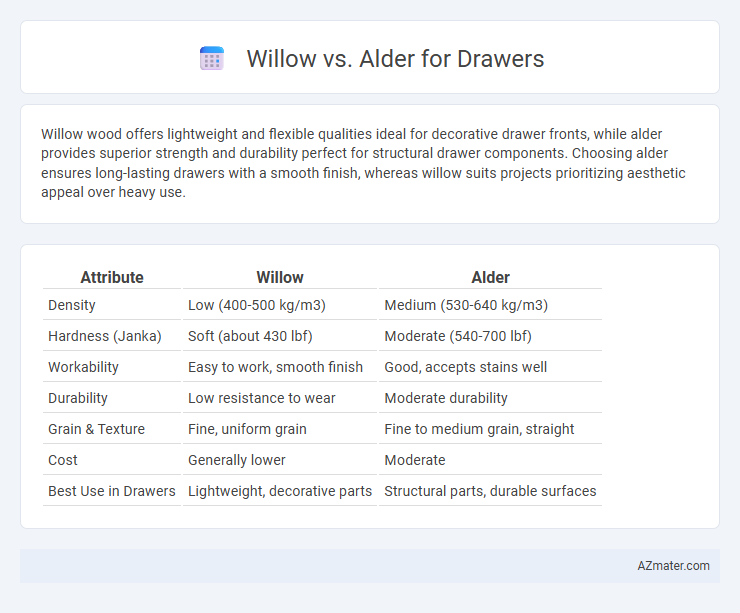Willow wood offers lightweight and flexible qualities ideal for decorative drawer fronts, while alder provides superior strength and durability perfect for structural drawer components. Choosing alder ensures long-lasting drawers with a smooth finish, whereas willow suits projects prioritizing aesthetic appeal over heavy use.
Table of Comparison
| Attribute | Willow | Alder |
|---|---|---|
| Density | Low (400-500 kg/m3) | Medium (530-640 kg/m3) |
| Hardness (Janka) | Soft (about 430 lbf) | Moderate (540-700 lbf) |
| Workability | Easy to work, smooth finish | Good, accepts stains well |
| Durability | Low resistance to wear | Moderate durability |
| Grain & Texture | Fine, uniform grain | Fine to medium grain, straight |
| Cost | Generally lower | Moderate |
| Best Use in Drawers | Lightweight, decorative parts | Structural parts, durable surfaces |
Introduction to Willow and Alder Wood
Willow wood, characterized by its light weight and fine grain, offers moderate strength and flexibility, making it suitable for delicate drawer construction. Alder wood is known for its smooth texture and even grain, providing durability and resistance to wear for functional and sturdy drawers. Both woods deliver unique aesthetic and structural benefits, influencing drawer performance and longevity.
Key Characteristics of Willow Wood
Willow wood is lightweight and flexible, making it ideal for drawer construction where ease of movement is essential. Its fine, even grain and pale color provide a smooth finish and aesthetic appeal, distinguishing it from the denser, more porous alder wood. Willow's natural resistance to warping and moderate strength ensure durability while maintaining a gentle texture that prevents damage to drawer contents.
Key Characteristics of Alder Wood
Alder wood is prized for its fine, straight grain and smooth texture, making it an ideal choice for drawers due to its workability and durability. This hardwood offers moderate strength with excellent stability, resisting warping and cracking over time, which ensures the longevity of drawer construction. Alder's warm, reddish-brown hue enhances furniture aesthetics, while its resistance to dents and ease of finishing provide a practical advantage over willow wood.
Strength and Durability Comparison
Willow offers moderate strength but is generally softer and less durable compared to alder, which features a denser grain and higher resistance to wear and impact. Alder wood's robust structure makes it more suitable for drawers that undergo frequent use, providing enhanced longevity and reduced risk of dents or scratches. Choosing alder ensures greater durability in drawer construction, while willow may be better suited for decorative or less load-bearing components.
Workability and Ease of Machining
Willow wood tends to be softer and less dense than alder, making it easier to shape but more prone to dents and scratches during machining. Alder offers more consistent grain structure and moderate hardness, providing smoother finishes and better durability when working with power tools. Both woods respond well to cutting and sanding, but alder's balance of firmness and workability often results in cleaner edges and less tool wear for drawer construction.
Aesthetic Appeal and Grain Patterns
Willow wood features a light, creamy color with subtle, wavy grain patterns that create a soft, natural aesthetic for drawer fronts. Alder offers a richer, warm reddish-brown tone with straight, pronounced grain lines that provide a more traditional and refined appearance. Both woods enhance drawer aesthetics, but willow's delicate grain suits rustic or contemporary designs, while alder's distinct pattern complements classic or craftsman styles.
Weight and Density Differences
Willow wood is notably lighter than alder, with a density around 400 kg/m3 compared to alder's denser 560-640 kg/m3 range, making willow ideal for lightweight drawer construction. The lower density of willow reduces overall drawer weight, enhancing ease of movement and reducing strain on drawer slides. In contrast, alder provides greater sturdiness and durability due to its higher density, making it suitable for drawers requiring more structural strength and resistance to wear.
Cost and Availability
Willow wood offers a lower cost compared to alder, making it a budget-friendly option for drawer construction. Alder is moderately priced but more readily available in furniture-grade lumber, ensuring consistent supply for manufacturing. Availability of willow varies regionally, while alder is widely sourced across North America and Europe, influencing both material cost and delivery timelines.
Environmental Impact and Sustainability
Willow wood for drawers offers a lower environmental impact due to its rapid growth rate and ability to thrive in wetland areas, promoting carbon sequestration and biodiversity. Alder wood, while slower growing, is sustainably harvested in managed forests, contributing to a balanced ecosystem and renewable resource use. Both woods support sustainable practices, but willow's quick regeneration makes it a more eco-friendly choice for environmentally conscious furniture production.
Best Uses: Willow vs Alder for Drawers
Willow wood excels in lightweight drawer construction with moderate durability, making it ideal for decorative or lightly used pieces. Alder wood offers greater strength and stability, suited for drawers subject to frequent handling and heavier loads. Choosing alder enhances longevity and resistance to wear, while willow provides a cost-effective option for aesthetic drawer designs.

Infographic: Willow vs Alder for Drawer
 azmater.com
azmater.com